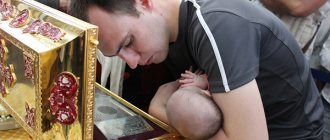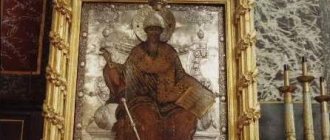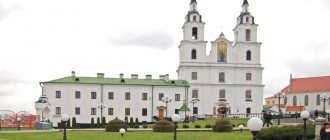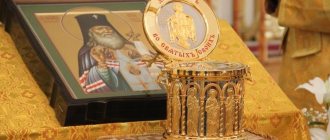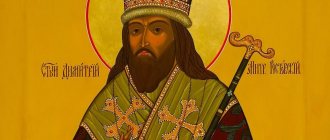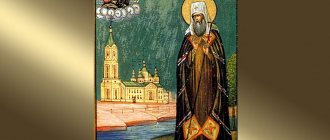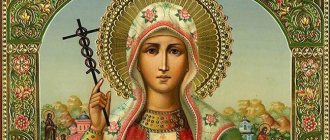It is believed that the relics of saints in temples, churches, and monasteries have a beneficial effect on the flock. They help those suffering adversity, calm the suffering and heal the weak. If the news spreads across Moscow, and even more so in a provincial city, that the relics of a saint have been brought, then people flock to see them, like a pop star. Such a relic is the pride of any temple. And if holy relics are suddenly found, then this event becomes epoch-making. Today you will find out what the relics of holy wonderworkers in churches and monasteries actually are. What do true Christians worship?
Old Believer Reciter Commissioner Qatar claims that in his personal library there is a book “Curiosities of Traditions”, author L. Lalande. It has been declared prohibited by the Catholic Church. It was confiscated and mercilessly destroyed throughout the 19th century. It is considered non-existent today. But the ancestors of Bogumil Katara saved one copy.
Who is L. Lalande - author of the book “Curious Traditions”
Before talking about why the book did not please the churchmen, it is worth saying a few words about the author.
Today you will not find any mention of L. Lalande and his biography. They erased a person from history. Meanwhile, this is a famous person of his time. His name is written in golden letters in astronomy.
Joseph Jerome Lefrançois de Lalande (French Joseph Jérôme Lefrançois de Lalande; July 11, 1732, Bourg-en-Bresse, near Lyon, France - April 4, 1807, Paris, France) - French astronomer, hiding behind the pseudonym L. Lalande.
At the end of the 18th century, Lalande observed 50 thousand stars. They were placed in a catalog known under the title “French Celestial History” (French: “Histoire c;leste fran;aise”). His name is included in the list of the greatest scientists of France. You can see this list on the first floor of the Eiffel Tower. He was even a foreign honorary member of the St. Petersburg Academy of Sciences.
As you can see, L. Lalande is both a serious scientist and an authoritative person. This one can be trusted.
Types of shrines
Shrines of Russia is a broad concept that includes various relics. Let's consider such types of shrines as Orthodox monasteries, miraculous revered icons and relics of saints.
Orthodox monastery
“A monastery is a church institution in which a male or female community lives and operates, consisting of Orthodox Christians who have voluntarily chosen the monastic way of life for spiritual and moral improvement and joint confession of the Orthodox faith” (Charter of the Russian Orthodox Church, Chapter XII, §1).
Since ancient times, monasteries have been centers of spirituality and strongholds of faith. Prayer for the whole world is a special service of monks and nuns, which is performed behind the walls of monasteries, separated from worldly life. Therefore, often the shrines of Russia are monasteries.
Each monastery has its own internal structure, in which the main officials are the abbot (abbot), treasurer, confessor and others. A person who, by his own will and the will of God, has left the world and wants to devote himself to special service to God is a beginner and is being tested. If he shows himself worthy of monastic life, he is tonsured into the monastic order.
Monasteries are divided into male and female. The largest, most famous and remarkable monasteries for spiritual exploits are called laurels.
The basis of the monastic spirit are the words of the Lord Jesus Christ Himself:
“If you want to be perfect, go, sell what you have and give to the poor, and you will have treasure in heaven, and come and follow Me” (Matthew 19:21).
Icons
An icon (from the Greek “image”) is a sacred image of persons or events of biblical and church history, which has doctrinal significance.
Since ancient times, the icon has been called the “Bible for the illiterate,” “the pictorial Gospel,” “wordless sermon,” “theology in colors.” The icon carries a deep symbolic meaning. The iconographic face has certain features that carry a spiritual essence.
For example, a high forehead reflects spiritual wisdom and thoughtfulness. Big eyes mean immersion in Divine secrets. Thin lips - abstinence and taming of passions and flesh. Elongated fingers - spiritual nobility and purity of deeds. Bowing the head means not being indifferent to the voice of God in the heart. Raising hands - prayer. A slightly bowed figure - meekness and obedience to the will of God. The main task of the icon is to help in the unity of God and man.
There are many cases when various miraculous events took place through holy icons. Moreover, each icon is endowed with God's grace and has the ability to become miraculous. A miracle is the result not of the properties of a particular icon, but of the strength and sincerity of faith of the person praying in front of it. It is no coincidence that icons are often the most famous shrines in Russia.
Saint Simeon of Thessalonica: “Depict with colors according to Tradition, this painting is as true as the Scriptures in books, and Divine grace rests on it, because what it depicts is holy.”
Relics
Relics are the remains of saints who are revered by the Church. This concept should be understood more broadly than just bodies. This means not only the remains, but also everything that remained after the life of the saints and came into contact with them (clothing, things).
The relics of holy saints carry special grace. They have a moral influence on the human soul, are real evidence of the saint’s life and closeness to God, and encourage believers to strive to imitate pious ascetics. The Bible says about the righteous: “Your bones will blossom” (Is. 66:14).
“Your relics are like a full vessel of grace, overflowing upon all who flow to them,” says the prayer to St. Sergius of Radonezh.
Hieromonk Job (Gumerov):
“The material objects used by the saint of God are sanctified and acquire healing powers. Moreover, the body of a saint, which becomes a pure vessel of God’s grace, can perceive supernatural powers of grace. The veneration of holy relics is based on this.”
Reverend Ambrose:
“If Christians so revered the things that belonged to the holy saints of God, then it is clear for what reasons they revered their bodily remains, or relics, and why the custom (approved by the Seventh Ecumenical Council and other local councils) arose to build churches only over the relics of the holy martyrs , - since in the first centuries Christianity spread and was established mainly through the sermons of martyrs and their suffering.”
The relics of saints in churches and monasteries are profanation
Why did L. Lalande’s work end up in the index of books banned by the church? Everything is banally simple. With the scrupulousness characteristic of astronomers, he examined all the holy relics kept in the monasteries and churches of Europe. And he came to a conclusion that was shocking even to himself. The relics of saints in churches and monasteries are, most often, pure profanation.
L. Lalande wrote his famous book during the time of Napoleon. At that time, freethinking flourished in France and the authorities did not really honor the Catholic Church. “Curiosities of Traditions” became a real bomb.
It turns out that European churches and monasteries store:
- 2 heads, 17 arms and legs and 5 torsos for St. Andrew the First-Called,
- 20 bodies and 26 heads of Saint Julian,
- 3 intact mummified prophet Elijah,
- 9 mummies of Apostle Luke,
- 18 heads and 12 hands of Saint Philip,
- 15 hands of John Chrysostom,
- 13 hands of Saint Sebastian,
- 30 bodies of St. Gregory,
- 2 torsos, 8 heads, 6 arms and legs of Saint Anne,
- 30 bodies of St. Gregory,
- 30 bodies of Saint Pancras.
- 11 index fingers, 7 jaws, 9 hands and 7 heads of John the Baptist.
In honor of the discovery of each head of the Baptist, special holidays were established in the Orthodox and Catholic churches.
Tolga Icon of the Mother of God
The Tolga Icon of the Mother of God is kept in the Tolga Monastery in Yaroslavl. There were three copies of this icon, but only one of them is miraculous. It was found in 1314 by Prokhor, Bishop of Rostov and Yaroslavl. A monastery was built on the site where the icon was found. There the image was kept until 1920, when the Bolsheviks handed it over to the Yaroslavl Museum. In 2003, the Tolga Icon of the Mother of God was returned to the monastery.
Many miracles are attributed to the image, including the flow of myrrh, the resurrection of a dead child and the healing of Tsar Ivan the Terrible from a leg disease. The latter, in gratitude, erected a stone cathedral in the monastery.
Multi-headed relics of St. John the Baptist in Syria
There is no need to talk about minor saints. Their limbs and relics found peace and veneration in incredible quantities throughout Europe. At least take it out by truck.
Sometimes things reach the point of complete absurdity. In one of the monasteries in Syria they keep the child's head of John the Baptist. And according to the biblical text, King Herod executed the already adult John. Where does a child's head come from then? Has one disappeared as unnecessary and another has grown? To such questions, the monks answer that this is a miracle of God. And you can only believe in it, and not talk about it.
Monks can be understood. After all, it is a rare monastery that owns such a miracle – the child’s head of John the Baptist. More than two dozen Syrian monasteries and temples can boast of the heads of the adult John. But according to Christian legend, the body of the Baptist was burned along with his severed head.
In his book, Lalande is amazed at the abundance of bodies and heads of the holy wonderworkers. He counted 3 bodies and 4 heads in Benedict, 11 bodies in Erasmus, 6 bodies in Dorothea, 4 bodies and 8 heads in Stephen, 7 bodies and 10 heads in William, 2 bodies, 4 heads and 63 fingers in Jerome, and in Julian – 20 bodies and 26 heads and so on in the same spirit.
“You know, the list is so huge that I am not able to submit it in full. And therefore I decide to publish L. Lalande’s book “Curious Traditions” in electronic version on the pages of the world wide web. Of course, it will take time, but it will be worth it,” Qatar assures.
They also surprise gullible believers with the relics of the rooster that crowed for Peter, the bones of the cows that the Egyptian pharaoh dreamed of, the skeleton of the donkey on which Jesus rode into Jerusalem... There is no end to this wonderful list. For example, how do you like the vessel with the sweat of St. Michael, collected after his struggles with the Devil. Or the sneeze of the holy spirit, the box with the last breath of Jesus...
Optina Pustyn
Optina Pustyn is idyllically picturesque: the edge of a pine forest, the playful Zhizdra River, and on the other bank there are fields from Levitan’s paintings. According to legend, it was founded by Opta, the repentant leader of a gang of robbers. As a monk, he took the name Macarius, which is why the hermitage was first called Makarieva. The monastery is famous for its tradition of eldership, which was started in 1829 by Elder Leonid. The Optina elders had enormous influence on the minds of people of various classes. Gogol was here three times. After visiting the Optina Hermitage, Dostoevsky’s “The Brothers Karamazov” was born. Leo Tolstoy had a special relationship with the monastery (as, indeed, with the church in general). During the Soviet years, the tradition was interrupted, but in 1988 the monastery reopened to parishioners and pilgrims, who line up in long lines to venerate the relics of the famous Optina elder Ambrose.
Photo: Maxim Osipov, CC BY-NC-ND 2.0
How to get there: by bus, car or train to Kozelsk, from where it is a few kilometers to the monastery (there is a minibus). Nearest airports: Kursk, Moscow. Website and Optina Pustyn
Holy relics in Moscow and Athos
You should not think that in Russia things are somehow different with the relics of holy wonderworkers and saints. The Orthodox Church keeps one head of John Chrysostom in the Epiphany Cathedral in Moscow, and the second in a monastery on Mount Athos.
This is what the magazine “Revolution and the Church” wrote in 1920 in the “Report of the VIII Department of the People’s Commissariat of Justice to the Congress of Soviets on the opening of the relics”:
“On October 22, 1918, when registering the liturgical property of the Alexander-Svirsky Monastery, Petrozavodsk province, in a cast shrine weighing more than 20 pounds, instead of the “incorruptible” relics of Alexander Svirsky, a wax doll was discovered.”
Then this message caused a storm among church officials and parishioners. People became interested in what was kept in other church crayons and caskets for relics. Special commissions were created in a number of provinces. They, in the presence of experts and representatives of the clergy, conducted 63 openings of the repositories of holy relics. Numerous falsifications on the part of clergy were revealed.
Silver tombs, often decorated with precious stones, contained, at best, bones that had turned to dust. More often - imitation of bodies in the form of iron frames wrapped in fabric. Or pieces of cotton wool and flesh-colored pieces of cardboard.
Icon of the Vladimir Mother of God
According to church tradition, the icon was painted by Evangelist Luke. From Jerusalem it came to Constantinople, and then, at the beginning of the 12th century, it was presented to Prince Mstislav. Several miracles are attributed to the icon, including deliverance from Tamerlane in 1395.
After the revolution, the icon was removed from the Assumption Cathedral of the Moscow Kremlin for restoration, and in 1926 it was transferred to the Historical Museum. There, the icon of the Vladimir Mother of God spent only 4 years, after which it was donated to the Tretyakov Gallery. Since 1999, the icon has been kept in the Church-Museum of St. Nicholas in Tolmachi.
Holy relics of Abraham the martyr made of cotton wool
The offices of the patriarchates also call for public examination and inspection of holy relics. In order to “eliminate any reason for mockery and temptation,” the crayfish are cleared of such items as a sardine box, brooches with the inscription “Shura” and similar debris. The “discovery” of these very items in the crayfish was documented in the autopsy reports. They are signed by representatives of the clergy.
As an example of the above, Bohumil Qatar cites the following protocols:
“Abraham martyr, Vladimir February 12, 1919.
After removing the covers, cotton wool of fresh origin was discovered, in which lay a group of bones of more than one person, at least two. One bone differs in appearance from all the others in its freshness, due to its density and whiteness. There is cotton wool inside the skull.”
Valley of Geysers on the Kamchatka Peninsula
A rare and majestic natural manifestation in the form of swirling steam, incessant roar and water splashes on the only geyser field in Eurasia.
Valley of Geysers - an unforgettable place
Travelers feel here as if on another planet. The play of colors gives the landscape a special beauty: the green of the flora is interspersed with yellow, purple and red shades of rocks covered with thermal algae and moss. The names of the geysers also match them, one of which is “Gates of Hell”.
Geyser "Gates of Hell"
Everyone who has managed to visit here falls under the charm of this region.
Holy relics of Artemy Verkolsky made of nails and bricks
“The relics of Artemy Verkolsky, Arkhangelsk province. December 20, 1918
A coffin divided into 3 parts. In the first part there is cotton wool. In 2nd church vestments. In the 3rd, a small red chest, tied with a cord and sealed with the seals of the Verkolsky monastery. Upon opening the chest, the following was found: ordinary coal, burnt nails and small bricks. There are no signs of bones.
The monks and Archimandrite Ioannikis were present at the autopsy. Some monks, saying, this is how we have been deceived until now, began to take off their monastic clothes and, throwing them into the corner of the church, said: “Enough of fooling us.” ... One of the village women, when she saw what was found instead of the relics, said: “I, a fool, came here last year. And when she approached the shrine, she trembled all over with fear, thinking that there really was an incorruptible saint here. But look here, what rubbish has been put in place of the saint.”
Golden Gate of Vladimir
The Golden Gate of Vladimir was built in 1164 under Prince Andrei Bogolyubsky. They led to the richest princely-boyar part of the city. In the old days, the gates were covered with sheets of gilded copper, which gave them a special solemnity. This was precisely the reason for the theft of the gates in 1238, when Vladimir was taken by the Mongol-Tatars. The gate, however, did not go far; while crossing the frozen Klyazma, the ice cracked and the gate sank. The doors were never found.
Unfortunately, due to fires and enemy invasions, the Golden Gate has reached us in a greatly altered form. They were restored several times, so that the ancient parts of the structure include only a wide passage arch with powerful side pylons and a battle platform above them, preserved in fragments.
Relics of Saints Prince Constantine and Shura
“Prince Constantine, his “children” Mikhail and Theodore, mother Irina, Murom. February 10, 1919
Four bags of bones. Cotton wool and rags, which are shaped like breasts. But when opening the bag in which Irina’s head was supposed to be located, it turned out to be a skull with a collapsed middle, stuffed, like the others, with cotton wool and rags. At the bottom of the shrine, under the heads of the figures on the left side, a bone brooch with the inscription “Shura” was found.
“Tikhon of Zadonsk, Zadonsk. January 28, 1919
Scull. A dried part of the tibia that turns into powder when touched. Cardboard painted flesh color. Falsification of arms and legs using cotton wool and cardboard. There is a slot in the glove in which flesh-colored cardboard is inserted, and the believers touch it. Ladies' stockings, boots, gloves. Instead of a chest there is an iron frame.”
Goden Cross
The Goden cross is an image of the crucified Christ, made of linden wood. The shrine was found in 1423 in the Sahota swamp. Nicholas the Wonderworker appeared to the shepherds, and soon a temple was built at the site where the cross was found. A large number of miracles are attributed to the Goden shrine, and perhaps it is because of this that the cross suffered so much damage in Soviet times. After unsuccessful attempts to burn or poison the tree with acid, the cross was thrown into the swamp, but several parishioners pulled the shrine out of the swamp and hid it in the Chrysostom Church. At the beginning of the 21st century, the cross was restored, and now you can worship it in the Church of St. John Chrysostom, which is located in the Yaroslavl region, in the village of Godenovo.
Holy relics of Sergius of Radonezh, moth-eaten
“Sergius of Radonezh, Sergiev, Moscow province. April 11, 1919
Moth-eaten rags, cotton wool, dilapidated human bones, a mass of dead moths, butterflies, larvae. In the skull, in wired paper of recent origin, there is light brown-reddish hair.
“Kirill Novoezersky, Belozersk February 1919
A doll depicting a person, with the shape of a human face and with all its parts, such as the nose, chin, etc. It seemed that under this cover there really was a person. Under the cover, in reality, only a pile of bones was found. Moreover, some, such as the femur, the back of the head box, retained their shape, but all the other bones turned into powder. The skull contains two copper coins from 1740 and 1747.”
Belokurikha, Altai region
Profile: diseases of the digestive system, ENT organs, skin, musculoskeletal system, nervous, endocrine, respiratory, cardiovascular and genitourinary systems
Altai recharges batteries, even if nothing special is done for this. In the cozy mountain resort of Belokurikha, walk along forest paths and pick mushrooms and berries. Buy local honey and eat it as a snack with herbal tea. Wait until nightfall and marvel at the beauty of the Milky Way. Go to a Russian bathhouse with a birch broom and a cool plunge pool - you will fall asleep in the evening, looking five to ten years younger. If you are serious about improving your health, choose a sanatorium and get ready for therapeutic baths, showers, mud, irrigation, saunas, as well as regular and hydromassage.
From Karelia to Kamchatka: 8 of the most beautiful mountains in Russia that are just tempting to conquer
Rotten relics of St. Dmitry of Rostov
"Dmitry Rostovsky, Rostov. April 26, 1920
A skeleton that has retained some of the skin on the torso and limbs in a decayed form, turning to dust. There is cotton wool in the skull. The appearance of the bone remains is no different from the ordinary remains of a rotten corpse.”
“Pitirim Tambovsky, Tambov province. February 29, 1919.
Metal doll, box-case in the shape of a human body and the length of an average person's height, folded, opening in the front and in the middle in both directions. There are bones covered in wax inside. A wax cast of the head containing small fragments of the parietal, occipital and temporal bones.”
“Mikhail Tverskoy, Tver May 18, 1919
Under a large number of covers, a white schema was discovered and there were bones in it in a disorderly manner. The skull lies with the lower jaw separated, the vertebrae along with the ribs. Those around the raku were embarrassed. There are circles of parishioners around the temple. The old peasant said: “But I believed and went to worship for 18 years.”
All these and many similar protocols, let me remind you, were signed by representatives of the Patriarchal Office.
3) Borobudur
Borobudur was discovered in the 19th century in the jungles of Java, Indonesia. This sacred temple is an amazing structure containing 504 Buddha statues and about 2,700 reliefs. The complete history of this temple is a mystery; it is still not known who exactly built this temple and for what purpose. It is also not known why such a majestic temple was abandoned.
How the relics of saints multiplied in monasteries and churches
In the Middle Ages, European alchemists and pharmacists believed in the healing properties of powders prepared from mummified remains. and for the production of various tinctures and elixirs. It was believed that such a drug almost bestows eternal youth. Tinctures on the remains of saints, of course, were especially valued.
Thus, the trade in relics became widespread. She brought in serious income. How could fake relics not appear here? The temptation to replace genuine relics with fake ones was great.
This is what the Commissioner of Qatar says about false relics of saints:
“Well, reader, did you learn a lot of unexpected things today? But most of the saints listed are again in use in the church, and they call you to bow to them. Of course, faith is your personal matter and it’s not for me to tell you. But you are also dealing with a man strong in the old faith, which knew no bones or rags. And even more so worship them.”
So the display of the relics of saints in monasteries and churches around the world is still a spectacle. Both in Moscow and in the Vatican. No matter the relics of a saint, there is no certainty about their authenticity.
Ivan Ivanovich A.
Kizhi
The Transfiguration Church in Kizhi - entirely wooden, crowned with 22 domes - looks like a magical palace from a fairy tale. The impression is enhanced if you are not lazy and get up early in the morning, when the fog spreads across Lake Onega. According to legend, when the church was being built, one of the craftsmen, having finished the work, threw the ax into the river and said: “There has never been such a thing and there will never be another!” Nearby is the second church - Pokrovskaya, now operating after a long break, and between them is a tented bell tower, the youngest building of the ensemble. Contrary to popular belief, nails were still used during the construction of Kizhi: first, wooden and later forged nails were used to secure ploughshares—wooden plates on the domes.
How to get there: from Petrozavodsk from May to September you can sail on a “meteor” or “comet”. In winter, hovercraft and helicopters fly to Kizhi. A special pleasure is to go on a cruise from St. Petersburg with a stop at Valaam and Kizhi. Nearest airports: Petrozavodsk, St. Petersburg. Website of the Kizhi Museum-Reserve
Arshan, Buryatia
Profile: diseases of the skin, digestive and respiratory organs, circulatory system, urinary, endocrine and musculoskeletal systems, metabolic disorders
In the mountains of Buryatia, right under the rocks and snowy peaks of the Sayan mountains, the Arshan resort is located. People are treated here with thermal mineral waters and sulfide silt mud. In your free time from baths, inhalations and physiotherapy, do not be lazy to explore natural beauty. In half an hour, without much effort, you will reach the waterfall on the Kyngarga River. The journey along the mountain trail to the Peak of Love will take 4–6 hours and another 3 hours on the way back; take water and a snack with you.
Nerpas and Circum-Baikal Railway: 11 sure ways to love Baikal
Tumninskie waters, Khabarovsk region
Profile: diseases of the skin, musculoskeletal system, peripheral vessels, ENT organs, nervous system
In the village of Tumnin in the Far East, everything is conducive to a digital detox: among the hills, only Beeline is accepted, the Internet is barely available. But you will have as much time as you want to invigorate your body with radon water, swim in the pool, take a steam bath and wander under the trees to the sound of bird trills. It’s better to stay at Tumninsky Spring or Goryachiy Klyuch - they have the best reviews.
Far East of Russia: Where to go and what to see
Paratunka, Kamchatka region
Profile: diseases of the skin and subcutaneous tissue, nervous, musculoskeletal and genitourinary systems, gynecological
50 km from Petropavlovsk-Kamchatsky, Paratunka awaits you - an intimate resort in the middle of wild nature. Recreation centers differ in prices and services, but everywhere there will be swimming pools with mineral water - warm and comfortable for swimming. It’s especially chic to soak in Paratunka in winter, when there are snow-covered hills all around. To not only relax, but also get some treatment, book a trip and get a referral to the Paratunka military sanatorium.
Guide: When to go to Kamchatka, what to do and how to save money
Lake Shira, Khakassia
Profile: diseases of the digestive and respiratory organs, cardiovascular, musculoskeletal and peripheral nervous systems, skin
The healing power of Lake Shira was first learned at the end of the 19th century, when gold miner Tsibulsky cured his radiculitis with regular bathing. Impressed by the effect, he set up yurts on the shore and began inviting those who wanted to relax. Later, a hospital was built on the lake, and in addition to water, they began to use mud and kumiss. Reviews of the current sanatorium are contradictory: many people like the treatment, the rooms and food are so-so. But you can always rent an apartment or cottage in the village of Zhemchuzhny on the shore and splash in the lake waters without additional procedures.
11 juicy ideas: Where to go in Russia in summer
